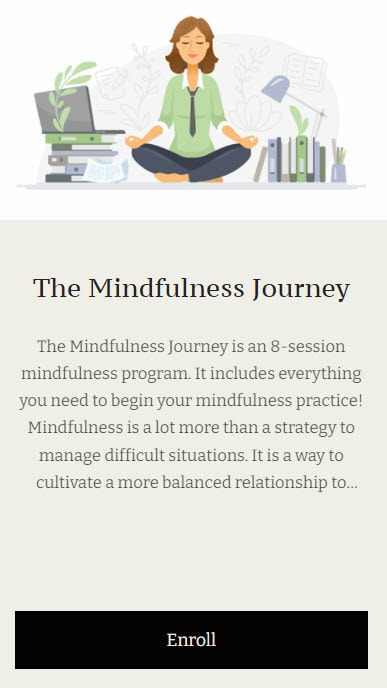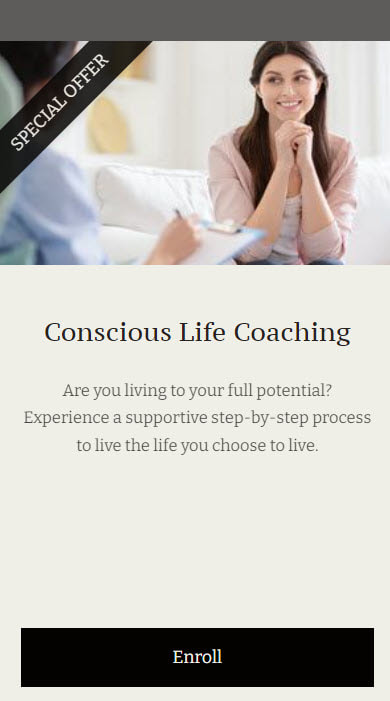|
Learn about how to use grounding techniques to relieve stress, anxiety, or unwanted thoughts. Sometimes, life throws you a curveball and you find yourself overwhelmed. Maybe you experienced a loss. Perhaps you find yourself pondering the meaning of life. Or maybe the current state-of-affairs makes you feel lost. Whenever you find yourself anxious or stressed, you can use grounding techniques to reconnect with yourself and the present moment. This science-based strategy may be helpful for anxiety, panic attacks, flashbacks, or even dissociation. Grounding techniques work by “grounding” you in the present moment and pulling you away from intrusive thoughts or feelings. This refers not only to having your “feet on the ground” but also “the mind on the ground.” When you turn your attention away from thoughts, memories, or worries, you can refocus on the present moment (Fisher, 1999). Grounding techniques are useful because they help you distance yourself from an emotional experience. When you experience negative emotions—for example, perhaps you accidentally remember a painful memory—the instinct of the brain is to start the involuntary physiological change known as the “fight or flight” response. Although this response keeps you safe by preparing you to face, escape from, or fight danger, memories are not a tangible danger. If you find yourself in moments like these, grounding techniques can help the body calm itself and return to the present moment. The 54321 Grounding TechniqueThe 5-4-3-2-1 technique is probably one of the most common grounding techniques. This technique helps by grounding you to the moment and reconnecting you to all five senses by naming:
The next time you feel anxious or are overthinking a problem, try the 54321-grounding technique to become more present in the moment. Play a Categories GameThis grounding technique helps your mind to focus on something else, ideally something more pleasant or neutral. For this technique, you can list a couple of categories and challenge yourself to list as many things as possible in those categories. You can ask yourself:
Do a Meditation ExerciseMediation is a very powerful grounding technique to reduce stress, depression, anxiety, and it can help you get out of your head and reconnect to your body. There are many types of meditation, such as the body scan, moving meditations, or loving-kindness meditation, so it’s important to try and figure out which one works best for you. Meditation has been shown to reduce stress, make you calmer, promote happiness (Mineo, 2018), and even reduce symptoms of PTSD in the US military (Seppälä et al., 2014). Focus on Your Breath Many clinical workers use breathing exercises to help patients be present in the moment. Focusing on breathing is a great tool for reducing stress and anxiety (Stefanaki et al., 2015). Breathing exercises work because they help you disengage with your mind and not pay attention to the distracting thoughts. You can do the simple exercise below before bed, when you wake up in the morning, or before an important meeting.
In SumGrounding techniques are strategies that may reconnect you with the present and may help you overcome anxious feelings, unwanted thoughts or memories, flashbacks, distressing emotions, or dissociation. You can try as many grounding techniques as you want: the more you try, the higher the chance you’ll find something that works for you. References
Want to be more confident? Learn science-based strategies to build your self-confidence. Are you seeking some self-confidence? Self-confidence can help us more easily reach our goals, stay motivated, and even boost our well-being. Self-confidence can be thought of as a person’s sense of his or her own competence and perceived capability to deal effectively with various situations—for example, performance, appearance, romantic relationships, and social interactions (Cheng & Furnham, 2002). It is thought that a self-confident person can rise to new challenges, take advantage of new opportunities, and deal with challenges or difficulties. They may also be more self-motivated, likely to pursue goals, and successful at manifesting—and why not? They believe they have what it takes to succeed. That's why confidence is such a valuable characteristic and one most of us likely want to build. If we are lacking in self-confidence, we may feel insecure, self-doubting, unsure, and self-conscious. Rather than approaching new situations, it may be our instinct to withdraw for fear of failure, ridicule, or incompetence. So, we may also be shy, nervous, and apprehensive. On a more positive note, if we are lacking confidence, we are also unlikely to be arrogant, egotistical, or assuming. So low confidence—just like high confidence—is associated with many positive qualities. How to Build Self-ConfidenceSelf-confidence grows in a kind of spiral pattern. Successful experiences lead to self-confidence, self-confidence leads to more successful experiences, and so on. If we can get ourselves into this positive feedback loop, we can start growing our self-confidence one experience at a time. Here are some tips to help with this. 1. Talk back to your inner criticAs a start, we may want to formulate affirmations that shift our negative beliefs about ourselves. For example, if we have thoughts like, "I'm not worthy", we can use affirmations like, "I have just as much worth as anyone else." Or if we have thoughts like "I suck at making friends," we might replace them with something like, "I have the ability to make new friends." It may not feel natural to say positive affirmations that go against what we currently feel to be true, but by practicing saying and thinking these things, we help create new pathways in our brains that grow stronger over time. 2. Affirm your positive qualitiesAll this involves is saying out loud (or in your head) that you possess as many positive qualities as you can think of. For example, you might say, "I am kind. I am smart. I am determined," and so on. Even if you have some negative opinions of yourself, these affirmations can help you focus on the things about yourself that you do like. 3. Affirm your skills and abilitiesIn addition to affirming your positive qualities, you can also affirm your abilities. In this case, you'd focus on saying statements that remind you of your skills. For example, you might say, "I am good at X. I am hard working. I am a good gardener," and so on. This can help you not only feel more confident in these skills, but it may also help remind you that you were able to build skills in the past so you can build new skills again in the future. 4. Practice self-compassionSelf-compassion involves treating oneself with kindness, recognizing our shared humanity, and being mindful and gentle when exploring the negative aspects of ourselves (Neff, 2011). Self-compassion can help us hold a more positive attitude towards ourselves, which can aid self-confidence (Owens, 1993). 5. Cultivate self-focused optimismBeing optimistic involves looking towards the future with hope and positivity. Optimism has been linked to all sorts of positive outcomes including greater well-being (Carver et al., 2010). There are some ways we can be more optimistic specifically about ourselves and our abilities. For example, you can do a visualization exercise where you imagine the best possible version of yourself in the future, focusing on the good things you do. You could also imagine yourself reaching your goals successfully. This can help your mind adjust to the idea of your success and help you feel more confident in pursuing your goals. In SumMany of us would like a little more self-confidence. Hopefully, the tools in this article helped you gain some insight and build some skills that'll boost your self-confidence in the long term. References
Discover what you can do to cope with stress and stop stressing yourself out. Most people feel stressed out now and then. In fact, stress is how our bodies naturally respond to demanding external conditions. Although we associate stressing out with a modern lifestyle, stress is nothing new. Even our ancestors faced stressful situations once in a while. Imagine a person living in a hunter-gatherer society coming face to face with a deadly predator while picking berries. To survive, this individual would most likely choose between fighting the predator or running away to safety. This type of survival mechanism is often referred to as the fight-or-flight response. Once triggered, the fight-or-flight response prepares our bodies to overcome a potentially harmful event by increasing our alertness and providing us with a temporary boost in energy (Dhabhar, 2018). As with any other emergency response, stress may only be helpful and effective against a short-term hurdle. Therefore, stressing out over an extended period may undermine your well-being. For example, stressing about the deadlines for your work or school calendar, the pile of bills on your coffee table, or the health or relationships can take a toll. Regardless of the cause, stressing out can drain your energy and leave you even more frustrated. Hence, recognizing when stress arises and acting may help you manage stress more effectively. What to Do When You Are Stressing OutNot all stress is bad. Stress allows us to push through difficult situations and overcome obstacles. However, when stressing out becomes excessive, it can interfere with your daily activities and your quality of life. Here are a few suggestions you may want to try when you feel stressed out. 1. Practice Mindfulness and Other Relaxation Activities Mindfulness allows you to be present in the moment and accept your sensations and feelings without judging them. Research suggests that mindfulness-based therapy is effective against stress, anxiety, and depression (Khoury et al., 2013). Similarly, doing yoga or breathing exercises can help you relax your mind and reduce your heart rate (Perciavalle, 2017). You can practice mindfulness and other relaxing activities on your own, with a friend, or with various instructional videos and smartphone apps. 2. Go Out in NatureMany people’s lives are disconnected from nature, contributing to their stress and anxiety. Even brief exposures to a natural environment may boost positive emotions and reduce stress (Nisbet, Zelenski, & Grandpierre, 2019). The good news is, even urban green spaces provide most of the mood-enhancing benefits of nature. So, when you feel stressed out, try spending some time in a natural environment. 3. Get Adequate SleepLack of sleep is linked to stress and anxiety (Minkel et al., 2012), and getting sufficient sleep may help you fight off stress. If you have trouble falling asleep, you may try limiting your caffeine exposure later in the day, eliminating your screen exposure close to bedtime, and meditating to unwind before going to bed. 4. Do Something FunHobbies and fun activities can help you shift your focus elsewhere and elevate your mood. By engaging in a hobby, you may be able to channel your energy into improving a skill, learning something new, and using your creativity. 5. Get MovingHuman bodies are not meant to remain seated all day. Research has linked physical inactivity to stress, and regular physical activity can diminish or reverse its adverse effects (Tsatsoulis and Fountoulakis, 2006). Moreover, exercises that moderately elevate your heart rate also help you fight cardiovascular diseases. If you can’t commit to an exercise plan, you might try taking movement breaks during the day, using a standing desk, or sitting on an exercise ball instead of an office chair. 6. Limit MultitaskingOur minds can pay attention to only one task at a given moment. When you attempt to multitask, you end up switching your attention quickly between distinct tasks. It may ease your mind if you prioritize your tasks and entirely focus on one task at a time. 7. Watch What You Eat and DrinkCaffeine may wake you up and give you a brief energy boost but consuming too much of it may make you feel irritated and jittery. Similarly, consuming alcohol during stressful times can help us relax in the short term but may add to stressing out later. Moreover, some of us may be emotional eaters, making poor food choices when stressed out, such as eating an entire tub of ice cream. Given that unhealthy food choices can hurt your waistline, cardiovascular health, and immune system (Kiecolt-Glaser, 2010), eating a balanced diet may help you avoid these health problems. 8. Foster Real ConnectionsHumans are inherently social creatures, and most people thrive when they have meaningful, healthy relationships. Therefore, surrounding yourself with supportive people and interacting with them in meaningful ways may ease your stress and anxiety. References
Check out these science-based self-care ideas to create a better self-care routine. What is self-care? Self-care is generally thought to be the activities that individuals undertake to improve or restore their own health (Levin & Idler, 1983). Self-care is thought to have originated from self-reliant individualism and from a belief that ill-health could be prevented. Indeed, self-care can have a positive impact on nearly every form of ill-health making it an extremely valuable practice (Levin & Idler, 1983). Luckily, there are lots of ways we can practice self-care. Here are some ideas to get you started: 1. Get OutdoorsRecent research tells us that daily contact with nature can help us reduce anxiety and depression while also helping us improve our health (Soga, Gaston, & Yamaura, 2017). Indeed, so many things about the outdoors can improve our health—the sun, the fresh air, the soil, the scent of trees. Exposing ourselves to these things regularly is one way to take better care of ourselves. 2. Listen to Soothing MusicDid you know that listening to relaxing music can reduce cortisol (an important stress hormone)? Well, research shows it can (Khalfa et al., 2003). More specifically, binaural beats (music with two tones played at slightly different frequencies to each ear) may be helpful for increasing focus (Garcia-Argibay, Santed, & Reales, 2019). 3. Practice Deep BreathingBy practicing deep breathing, we activate our parasympathetic nervous system—our calming 'rest and digest' system. One simple breathing practice is box breathing. Box breathing involves breathing in for a count of four, holding for a count of four, breathing out for a count of four, and then holding for a count of four. Try this for a few rounds to see how it makes you feel. 4. Cultivate Positive EmotionsTo generate positive emotions, we can try thinking positive, being more optimistic, savoring the good moments, or even doing loving-kindness meditation. Boosting positive emotions can fuel an upward spiral of positivity, helping us feel better, improve social interactions, and so on (Fredrickson, Mancuso, Branigan, & Tugade, 2000). 5. Try Different Self-Care ActivitiesSometimes people get frustrated when they try a self-care activity—maybe an activity that tons of people have been raving about—and it doesn't really help them or feel like the right fit. If that sounds like you, then it can be helpful to try out some other strategies. For example, things like mindfulness and eating vegan don't work for everyone. Try out some different self-care activities (we list some more below) to find what works for you. 6. Build Self-AwarenessLearning to pay attention to what is helpful and not helpful can take practice. For example, maybe you've been exercising every day but are starting to feel worn down. In that case, exercise might not be the type of self-care you need right now. In general, paying attention to how your thoughts and behaviors make you feel—in the short-term and the longer-term—can help you make the most of self-care. References
How do you control, process, and release negative emotions? Find out here.  The dictionary defines negative emotion as "an unpleasant, often disruptive, emotional reaction." But negative emotions also have functions. Fear motivates us to engage in either fight or flight in response to a threat or predator. Negative emotions like jealousy, for example, are thought to motivate us to restore important social bonds in the face of threats. Negative emotions like embarrassment motivate others to forgive us if we have done something wrong. And negative emotions like sadness motivate sympathy and lead others to help us more (Keltner & Kring, 1998). As you can see, even though negative emotions feel bad, they have important functions that help us have experiences that make us feel better and even thrive in the longer term. This is a big part of why avoiding negative emotions—or shoving them down with suppression or repression—isn't good for us (and it may not even really work, but that's a more nuanced discussion). So instead of running from our negative emotions, we're better off learning to deal with and process our negative emotions in healthy ways. We'll talk more about that below. Negative Emotions & HealthWe might assume that negative emotions are bad for our health, but it's not quite that simple. Whether we express, suppress, or repress our negative emotions makes a big difference for our health (with suppression and repression being the less healthy choices). In addition, whether we experience positive emotions along with our negative emotions makes a big difference too (Hershfield, Scheibe, Sims, & Carstensen, 2013). Some research suggests that if we can feel some positive emotions along with our negative emotions, this might be the best option. We get the benefits of negative emotions without so many of the pitfalls. As the researchers put it, this strategy of "taking the good with the bad" might be the best for our health because we are able to deal with and process the negative emotions and possibly find some good in difficult experiences (Hershfield, Scheibe, Sims, & Carstensen, 2013). How to Control Negative EmotionsEven though negative emotions can have some benefits, there may be many times when we want to control them. Luckily, the truth is that there are a lot of strategies we can use to control our emotions. We can decrease negative emotions and increase positive emotions through processes known as emotion regulation. Some of the most well-known, effective emotion regulation strategies are:
Some well-known ineffective emotion regulation strategies are
How to Manage Negative EmotionsWe talked a bit about how negative emotions have important functions, especially social functions. And we just talked about how to manage our emotions effectively. To deal with emotions effectively, these two things need to be balanced. For example, if someone is mistreating us and we're angry yet we try to implement the emotion regulation strategy of acceptance, we might unintentionally cut our anger short, preventing us from standing up for ourselves and stopping any further mistreatment. Or, if we're feeling afraid, our gut might be telling us that we need to pay attention to possible threats. Perhaps therefore having a little bit of anxiety helps improve our effort and performance (Hardy & Hutchinson, 2007). So, controlling our negative emotions might not actually be the best plan of action, at least not all the time. Instead, we might be better served by processing and then releasing negative emotions. This way, they hopefully won't pop back up or cause problems in other areas of our lives. References
Learn how to get out of your head and reconnect with your body. The human mind can solve almost any type of problem, but what happens when problem-solving runs wild in our minds? We are so good at identifying problems and imagining scenarios that sometimes it is hard to stop. And being in our heads too much can make it hard to move past difficulties. What Does It Mean to Be in Your Head?To be in your head usually means overthinking or overanalyzing a situation. Your mind can “wander” to the future, and you might worry about things that can possibly happen, or it can “wander” to the past and replay the bad events that happened previously. When you’re in your head, you might wonder if your friend secretly hates you because it took them more than a few hours to answer your text. Or you might ruminate about why you were passed over for a promotion. One study clearly shows that you’re less likely to feel happy if you’re in your head. In the study, participants were asked at random times what they were doing, whether they were thinking about a task or not, and how happy/unhappy they were. Researchers concluded that “a wandering mind is an unhappy mind” (p. 932; Killingsworth & Gilbert, 2010). They also point out that although our human capacity to think about what’s not happening right now served us well at some point, it came at an emotional cost (Killingsworth & Gilbert, 2010). If being in your head means overthinking or overanalyzing a situation, getting out of your head means being present in the moment and letting go of the unhelpful thoughts. If you get out of your head, it’s more likely that you’ll be happier than before. Rumination, or continuously thinking over the same thoughts, is a well-established risk factor for depression and anxiety. For example, those who engage in this type of behavior have increased depressive symptoms and are more at risk for the onset of major depressive disorder and anxiety symptoms (Harrington & Blankenship, 2002; Nolen-Hoeksema, 2000). How to Get Back into Your BodyThe mind-body connection has been a topic of conversation for many years. Researchers keep showing that anxiety and depression have a negative impact on our bodies—for example, they can contribute to insomnia, high blood pressure, a decrease in immunity, gastrointestinal issues, and heart problems (Alberts et al., 2013). Considering that being in your head, overthinking, and rumination are associated with anxiety and depression, it’s important to learn how to get out of your head and into your body. Here are a few suggestions to get you started in reconnecting with your body: Be aware of what is happening.If you find yourself too much in your head, it’s important to be mindful of when it happens and what the triggers are. For example, you could be overthinking more about the future after an important presentation at work or after a meeting with your boss. The first step to getting better is acknowledging what’s happening and being mindful of the situations that trigger this reaction. Meditate.Meditation has many benefits for depression, anxiety, concentration, and even cognitive performance. Meditation can help you get out of your head and into your body because it works to bring the focus into the present moment and into your body. If you’re just starting, you might notice your mind wandering (even to the things you were doing before), but that’s ok. Just observe the wandering in a non-judgmental way. There are many meditations focused on the mind-body connection, such as body scans or moving meditation, and it doesn’t matter which one you choose; just use what works for you. Learn how to breathe.Sometimes, anxiety makes us feel out of breath, so what better way to combat it than learning how to use breathing as an exercise to relieve stress? Breath focus is commonly used to increase relaxation, and recent studies show it can also benefit depression, stress, and mental health (Seppala et al., 2020), and it can even reduce PTSD symptoms in US military veterans (Seppala et al., 2014). Take a step back from your thoughts.It’s important to make the distinction between your thoughts and you. You are not your thoughts. Take a step back and notice what’s happening. Then, you can freely choose how to respond, rather than just reacting to your thoughts. Write in a journal.Daily journaling has been highly recommended lately to manage stress and combat anxious thoughts. When you write, you work through your thoughts, what happened throughout the day, or what you’re ruminating over. Studies show that journaling reduces physical symptoms, health problems, anxiety, and increases well-being (Smyth et al., 2018; LaClaire, 2008). There are many types of journals and prompts to use, so it’s important to find out which one works best for you. Challenge your thoughtsYou are not your brain or your thoughts. This may sound strange, but you don’t have to believe everything your mind thinks. You are a witness of your thoughts, but you are not them. If you’d like, you can write down your thoughts and ask yourself if there’s any evidence to support your thinking process or to challenge it. References
Learn about how to increase your quality of life by cultivating healthy habits. Although cultivating healthy habits might seem daunting at first, it is beneficial for your health to nourish yourself, both physically and spiritually. Studies show that healthy habits can contribute to healthier and longer life expectancy (Li et al., 2020). Here are some key healthy habits to focus on. A Healthy DietWe eat to live, and we live to eat. People with healthy eating patterns live healthier, longer, and are at lower risk for numerous diseases, including heart diseases, type 2 diabetes, or obesity. For those who have chronic conditions, eating healthy may help them manage these conditions and prevent complications (CDC, 2021). What to do:Eat the RainbowAccording to the CDC data, fewer than 10% of children and adults eat the recommended daily number of vegetables (CDC, 2021). When you “eat the rainbow,” you eat many colorful fruits and vegetables. These contain phytonutrients that can protect us from manic chronic diseases. Some fun examples include tomatoes and cranberries (red), carrots, peppers, and bananas (yellow and orange), spinach and avocado (green), blueberries, grapes, eggplant, and purple cabbage (blue and purple), cauliflower, garlic, and onions (white) (McManus, 2019). Drink WaterDrinking water has many important benefits for a healthy lifestyle. You can drink other beverages, of course, but the main beverage should be water or unsweetened tea. You can also add fruit pieces into your water to flavor it naturally. Drinking water has been linked with higher diet quality, reduced appetite, and weight in a healthy range (Stookey, 2016; Barcamontes-Castelo et al., 2019; Gazan et al., 2016). Eat SlowlyThe speed at which you eat impacts how much you eat because your appetite is controlled by hormones. Although hormones tell your brain if you’re still hungry or you’re full, it takes about 20 minutes for the brain to receive these signals. Also, faster eaters have been shown to eat more and have a higher body mass index (BMI) than slow eaters (Teo et al., 2020). So, slowing down when you eat can make you eat less and keep a healthy weight. Bake or RoastBaking or roasting instead of frying can significantly impact your overall health. If you’re eating something fried, some potentially toxic chemicals are formed during the frying process. These components might increase the risk of cardiovascular disease, blood pressure, and obesity (Poursafa et al., 2017). So, try baking veggies and meat, poaching eggs, or slow cooking a stew. Healthy Sleep HabitsResearchers show how good things happen when we sleep, and bad things happen when we don’t. What to do:Be ConsistentEveryone needs sleep and sleep is an important part of a healthy lifestyle. According to the CDC, most adults need between 7 and 9 hours of sleep every night. It’s ok to miss a few nights of sleep here and there, but sleep deprivation is linked to poor mental health, heart disease, kidney disease, higher blood pressure, diabetes, and stroke. Sleep is very important for your health, as it is involved in healing and repairing your blood and heart vessels, and it allows the body and mind to recharge. Set a Fixed Sleep TimeSure, sleeping in is great, but having a consistent sleep schedule has numerous benefits. Your body might have a hard time resting if you constantly wake up and go to bed at different times. If you’re consistent with your sleep and waking times, it can increase the quality of your sleep (Giannotti et al., 2002). So, choose a schedule that works for you and try to stick to it even during weekends. Wind DownRelax and clear your mind before going to bed: take a hot shower, read a book, do a meditation exercise, or listen to music. Relaxation techniques before bed may help you fall asleep faster and have better sleep. Healthy Habits for Mental HealthIn addition to taking care of our bodies, we can benefit from taking care of our minds as well. What to do:Try MeditationWhether you do a mediation exercise before bed or a walking meditation during the day, it can significantly improve your quality of life, reduce stress and anxiety symptoms, and keep you more attuned to the present moment. Mediation is a great way to reconnect to your body and to bring awareness to the here and now. ConnectHaving an emotional support system is linked to better physical and mental health, including lower levels of anxiety and depression, less stress, protection against post-traumatic stress disorder, and lower mortality (Taylor, 2011). You can build connections by catching up with an old friend, spending quality time with a loved one, or cuddling a dog. You can grow your circle of friends or strengthen the connections that you already have. Either way, staying connected to others has numerous mental health benefits. Take a BreakSometimes the best way to improve your mental health is to take a break from what’s stressing you out. If you’re tight on time, you can do breathing exercises or a short meditation, but if you have more time, you can also do other things that you enjoy doing but can’t because you’re always too busy. Take a walk in a park, visit a museum, or call a friend—it may instantly make you feel better. References
Explore the many different things that contribute to resilience. In life, we all face stressful experiences. But each of us is very different in how we cope with these experiences. Some of us cope well and may even grow and improve because of stress. Others struggle and may even develop mental health issues in the face of stress. Resilience is the set of personal qualities that enable us to thrive in the face of adversity (Connor & Davidson, 2003). It may involve being calm in difficult situations, implementing effective coping mechanisms, and handling criticism well. Why is Resilience Important?Ongoing stress can be hard on our mental and physical health. Personal resilience can buffer us from these effects, shutting down the stress cycle and HPA-axis, enabling us to better fight off illness and other negative outcomes (Gaffey, Bergeman, Clark, & Wirth, 2016). But resilience can mean different things to different people. For example, to someone who is extroverted, resilience may mean spending extra time with friends. To an introvert, resilience may mean spending more time alone. Although each of us may cope with struggles by using different strategies, the key is to know what works for us and in which circumstances. How to Be More Resilient1. Practice AcceptanceSo much pain is created from our tendency to fight the things we cannot change. But the more time we spend getting upset about the uncontrollable situations in our lives, the more time we spend stressed or angry instead of focusing on how we can make the future better. Therefore, acceptance is linked to positive well-being (Ranzijn & Luszcz, 1999). 2. Strive for Self-KnowledgeSelf-knowledge is essential to resilience. If we do not know ourselves well enough to cope with stressors in ways that are effective for us, then we are likely to struggle. For example, maybe we cope by drinking alcohol or using drugs when we're upset. But the next day, we just end up feeling worse. By developing self-knowledge, we can take actions that help us recover from difficulties more easily. 3. Take Care of YourselfWhen we're sick, tired, and malnourished, we have a harder time responding to any type of stress, big or small. Our bodies just don't have the resources. For example, research has found that sugar intake is related to depression (Knüppel et al., 2017). If we focus on being healthier, we are likely to boost our resilience. We can do this by eating more nutritious food, engaging in moderate exercise, and sleeping when we're tired. 4. Prevent BurnoutBurnout is a very real phenomenon that includes emotional exhaustion and cynicism (Maslach & Jackson, 1981). Research has shown that there are several causes of burnout including too much work, not enough control, not enough pay, social issues, and a mismatch in values (Maslach & Leiter, 2016). If we’re burned out, our resilience is at an all-time low. This is why it's so important to prevent burnout before it gets to this point. If possible, try to get out of jobs or roles that are not a good fit for you. Take breaks whenever possible. And be sure to relax during your time off. 5. Practice Self-LoveSelf-love (or self-worth, self-confidence, self-esteem, etc...) may be a crucial part of what it means to be resilient. Positive self-views are closely linked to positive outcomes like happiness and well-being (Miller Smedema, Catalano, & Ebener, 2010). This may be because if we feel bad about ourselves, it colors every other aspect of our lives. We set ourselves up for disappointing situations and then we blame ourselves for them. By cultivating self-love, we can hopefully respond to stress in healthier ways. 6. Build Social ConnectionsNo matter what we're doing, we feel better when we're doing it with others. That makes social connections a crucial component of resilience. In fact, one of the most reliable ways to boost well-being is by developing high-quality social relationships and by feeling socially connected to the people in your life (Holt-Lunstad, Robles, & Sbarra, 2017). 7. Take a Step BackSometimes when we're going through something difficult, we get so immersed in it that we can't see straight. Our emotions overwhelm and our perspectives narrow. That's why resilience often means being able to take a step back to look at our situation from outside ourselves. More specifically, if we look at our situation as if we were “a fly on the wall” or "a passerby on the street", we can get some much-needed objectivity that can help decrease our negative emotions. This strategy is known as emotional distancing, and it can help us feel better during difficult times (Ayduk, & Kross, 2010). 8. Make MeaningIt's human nature to try to make meaning of our challenges. We often create explanations in our minds for why things happened to us and why they happened the way they did. This can help us cope with loss and other stressful events (Park, 2008). That's why meaning-making can be a key part of resilience. If we instead think that bad things happen for seemly no reason, we can end up feeling lost or out of control. In SumResilience is a powerful tool for well-being. But it is also a complex, multifaceted concept. Hopefully, this explanation helped clarify how to be more resilient in your life. References
What is emotional health, and how do you boost it? Here are some science-based tips. Emotional health is defined as a lack of mental disorders, but it also includes positive emotional characteristics, like resilience, self-efficacy, and vitality. Given how many different aspects of mental and emotional health there are, there are lots of different things we can do to improve our emotional health. Here are a few things you can do: 1. Do Things You EnjoyAn easy way to get an emotional boost is to do activities that you enjoy. Go out to eat with friends, play games, do crafts, or get a new hobby. Just doing fun things can go a long way in helping your mental and emotional health (Catalino, Algoe, & Fredrickson, 2014). 2. Build a Better Relationship with TechnologySpending too much time on our phones or online isn't good for our mental and emotional health. But if we learn how to interact with our technology in healthy ways, it doesn't have to be bad for us. You can start by learning how to have more positive interactions online (e.g., practicing kindness or gratitude online) and using technology to connect with others. 3. Be Kind to YourselfMany of us are so mean to ourselves. We might have a vicious inner self-critic, or we might find that we judge ourselves harshly for any mistakes we make. But the truth is, we all make mistakes and have flaws. Self-acceptance, despite those flaws, is a key to happiness. So be nice to yourself and give yourself a break. You could work on building skills, like self-compassion and a growth mindset. 4. Practice GratitudeThe more we practice gratitude, the happier we are likely to be. And gratitude is easy. You could write a gratitude journal, make gratitude lists, share your gratitude with others, or even write a gratitude letter to someone you never properly thanked. 5. Use Positive ReappraisalPositive reappraisal is an emotion regulation strategy that we can use to reinterpret a negative situation in more positive (or less negative) ways to make us feel better. If we don't use reappraisal (or we're not very skilled at it), this can lead to lower emotional health (Ford & Troy, 2019). So, practice reappraisal to get better at it and make the most of it. 6. Add Positive Information to Your BrainThe more information our brains have on a subject, the easier it is to recall anything related to that subject. That means if we have more positive words, info, and memories in our brains, it should be easier to recall the positive stuff. One way to add more to the "positive stuff" in your brain may be to memorize words that have been rated as highly positive or spend time focusing or thinking about positive things. In SumThere are many ways to start boosting your mental and emotional health. By trying these out, you can likely feel a bit happier. Continue with these and engage in even more activities to see your emotional health grow. References
Strategies to boost positive emotions, decrease negative emotions, and feel better. Do you tend to feel a lot of negative emotions? Do you feel bad about yourself? Or do you feel unhappy about your place in the world? Well, the science has shown us that we actually have a lot of control over our feelings and well-being. So here are 6 science-based tips to help you feel better. 1. Explore Your Emotional Goalsthere? Take a moment to ask yourself what exact emotions or experiences do you want to have when you 'feel better'? Here are some emotions to reflect on. Try to identify the top 1 or 2 emotions you want to feel.
2. Pursue Your Desired EmotionsOnce you know which emotions would make you feel better, you can take action to experience them more often. If you want to feel excitement, for example, plan a trip to do something new and invigorating. If, on the other hand, you want to feel relaxed, plan to get a massage or practice deep breathing. By knowing what your emotional goals are, you can more easily achieve them. 3. Practice GratitudeWhen we're not feeling good, it can be hard to be grateful for anything. But practicing gratitude for the things in our lives that are going well can help us feel better. By doing so, we shift our focus onto the good rather than the bad. You can write a gratitude journal or share your gratitude with others. Both are good ways to cultivate gratitude skills. 4. Try Not to Feel Bad About Feeling Bad!If you just want to feel bad for a little while, that's okay. Negative emotions have important functions that help us take better care of ourselves. Sadness can help us get support from others, anxiety can help us prepare for threats, and anger can help us stand up for what we believe in. But just be careful that you're not holding onto negative emotions that aren't benefiting you. Let go of resentments, shame, and self-blame in exchange for taking actions to improve your life. 5. Treat Yourself BetterIt's not always easy to boost self-esteem or self-worth because we often set up our lives in ways that confirm what we already believe about ourselves. But we can start by being self-compassionate (MacBeth & Gumley, 2012). And we can feel even better by working to understand the people or experiences that make us feel bad and learning how to say 'no' to those people or experiences. By treating ourselves better in small ways, we can build momentum and self-efficacy that can hopefully help us feel better in time. 6. Shift Your FocusWe often feel worse after a breakup, job loss, or other rejection. If we focus on how we were rejected or failed, we're likely only making it worse, stewing in our emotions until they become unbearable. Shifting our attention to something else can make a massive difference. If we're up for it, we can shift to focusing on the positive things—we can savor the good times or imagine good things in our future. Or we can simply live in the present moment. Even picking up an object, like a pen, and naming everything we see and feel related to that pen, can help us shift our focus away from the negative. References
|
AuthorPamela (Pami) Parker currently serves as a holistic practitioner, coach and teacher. Her intention is to be a compassionate guide to those who choose to experience a healthier, happier and more peaceful way of life. Categories
All
|
Company Details
The Self-Care Cafe is a member of The Conscious Center
Dutch Chamber of Commerce (KvK) Registration #64532593
Taxation (VAT) Number: NL670496157B01
Privacy Policy
The Self-Care Cafe is a member of The Conscious Center
Dutch Chamber of Commerce (KvK) Registration #64532593
Taxation (VAT) Number: NL670496157B01
Privacy Policy











